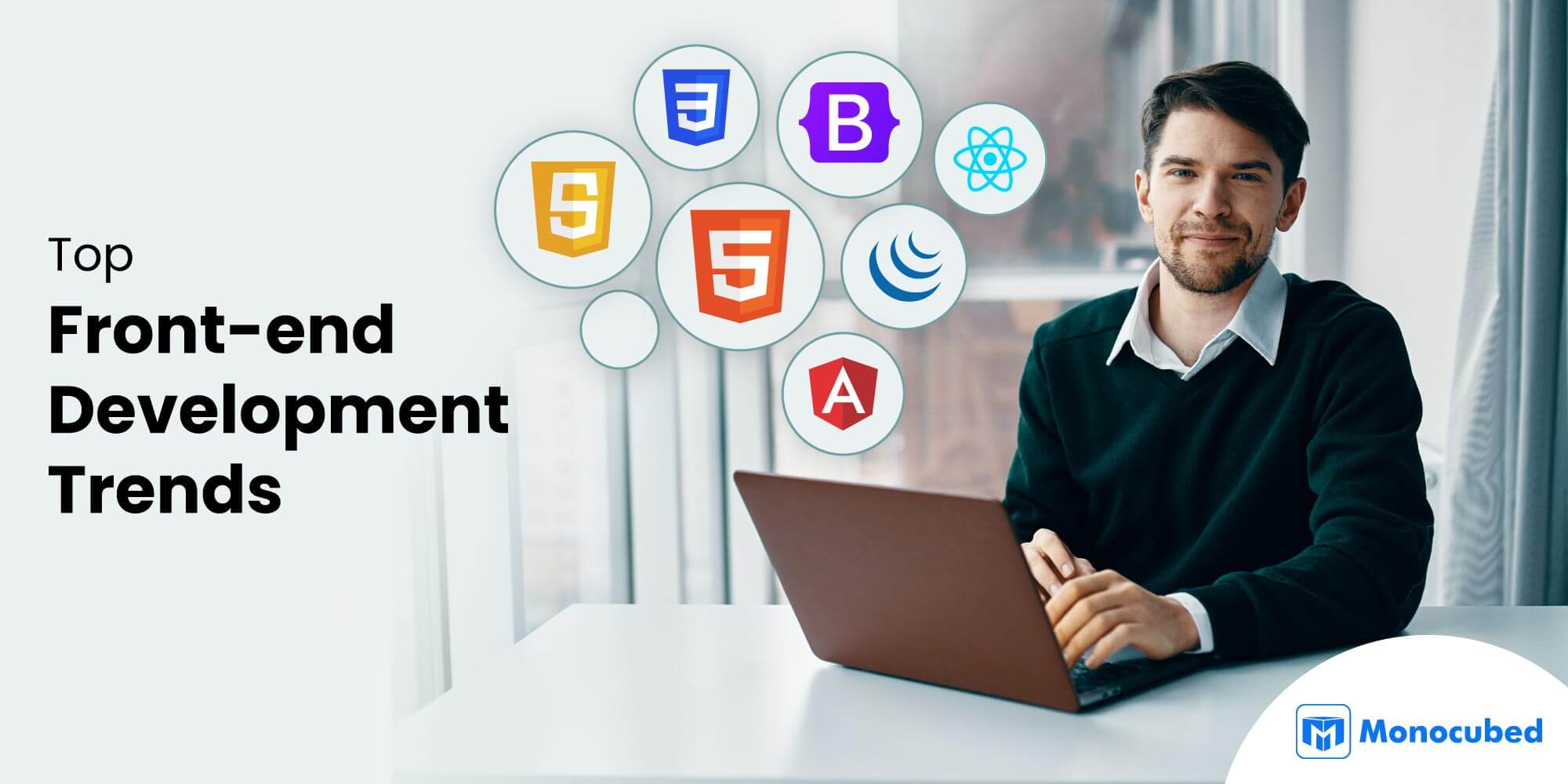Are you a front-end developer or someone aspiring to dive into the world of web development? If so, you are in the right place.
In this article, we will explore the exciting world of front-end development trends that are shaping the future of web development. Whether you are a seasoned pro or just starting, staying updated on the latest trends is crucial in this rapidly evolving field.
We will cover the most prominent trends, giving you a comprehensive overview of front-end development.
Table of Contents
11 Latest Trends in Front-End Development
Here are the latest front-end development trends to consider.
-
Responsive Web Design
Responsive web design is a cornerstone of modern web development. It’s about creating websites that adapt seamlessly to various screen sizes, ensuring a consistent user experience across devices. Here are some key points related to responsive web design.
- Mobile-First Approach
Start by designing for mobile devices and then scale up for larger screens. This approach aligns with Google’s mobile-first indexing, which prioritizes mobile-friendly websites in search rankings. - Flexible Grid Layouts
Use grid systems like CSS Grid and Flexbox to create flexible and responsive layouts that adjust to screen dimensions. - Media Queries
Implement media queries to apply different styles and layouts based on screen sizes, improving the user experience on both small and large screens.
- Mobile-First Approach
-
Progressive Web Apps (PWAs)
Progressive Web Apps (PWAs) are web applications that offer a native app-like experience while running in a web browser. They are becoming increasingly popular due to their enhanced performance and user engagement. Here are some insights into PWAs.
- Offline Functionality
PWAs can work offline or in low network conditions, making them ideal for users in areas with inconsistent internet access. - Service Workers
Utilize service workers to cache assets, ensuring faster loading times and a reliable user experience. - Add to Home Screen
PWAs can be installed on a user’s home screen, providing quick access, similar to native apps.
- Offline Functionality
-
Single Page Applications (SPAs)
Single Page Applications (SPAs) load a single HTML page and dynamically update content as users interact with the app. This approach offers smooth and responsive user experiences. Here’s what you need to know about SPAs.
- JavaScript Frameworks
Popular frameworks like React, Angular, and Vue.js are often used to build SPAs due to their capabilities in managing complex UI components. - Routing
Implement client-side routing to enable navigation within the application without full page reloads. - API Integration
SPAs often interact with REST or GraphQL APIs to fetch and display data dynamically.
- JavaScript Frameworks
-
WebAssembly (Wasm)
WebAssembly (Wasm) is a low-level bytecode format that enables high-performance execution of code in web browsers. It’s opening doors for complex and resource-intensive web applications. Here’s how Wasm is impacting front-end development.
- Multilingual Support
Wasm supports various programming languages like C, C++, and Rust, allowing developers to leverage existing codebases. - Near-Native Speed
WebAssembly runs code at near-native speed, making it suitable for computationally intensive tasks, such as gaming and real-time data processing. - Browser Support
Major browsers like Chrome, Firefox, and Edge have robust support for WebAssembly, making it a viable technology for web developers.
- Multilingual Support
-
Voice User Interfaces (VUI)
Voice User Interfaces (VUI) are transforming how users interact with web applications by using voice commands. This trend adds a new dimension to user experience and accessibility. Here’s what to consider with VUI.
- Voice Recognition
Leverage speech recognition APIs to convert voice input into actionable commands or queries. - Natural Language Processing (NLP)
Implement NLP to make VUIs more conversational and user-friendly. - Accessibility
VUIs enhance accessibility, making web applications usable for individuals with disabilities or those looking for hands-free interaction.
- Voice Recognition
-
Motion UI and Microinteractions
Motion UI and micro-interactions add flair and usability to web applications. They involve the use of animations and subtle interactions that engage users. Here’s how to make the most of these trends.
- Animation Libraries
Use libraries like GreenSock (GSAP) and CSS animations to create smooth animations and transitions. - User Engagement
Motion UI and micro-interactions can guide users’ attention and make the user experience more enjoyable and interactive. - Performance Considerations
Optimize animations to ensure they don’t impact page load times negatively.
- Animation Libraries
-
Augmented Reality (AR) and Virtual Reality (VR)
Augmented Reality (AR) and Virtual Reality (VR) technologies are breaking new ground in front-end web development, offering immersive experiences. Here’s what you need to know.
- WebXR
WebXR is a set of standards that enables VR and AR experiences on the web. Consider using frameworks like A-Frame to develop immersive content. - E-commerce and Gaming
AR and VR are particularly relevant in eCommerce for product visualizations and gaming for immersive gameplay. - Performance Challenges
High-quality AR and VR experiences require significant processing power, so optimize for performance.
- WebXR
-
Web Accessibility (A11Y)
Web accessibility (A11Y) is an ongoing trend focused on making web applications inclusive and usable for all. Here’s why A11Y should be a part of your front-end development strategy.
- Legal Compliance
Many countries have legal requirements for web accessibility, and non-compliance can result in penalties. - User Experience
Web accessibility enhances the experience for people with disabilities, but it can also improve the experience for all users. - Testing Tools
Utilize accessibility testing tools and guidelines such as WCAG to ensure compliance.
- Legal Compliance
-
JAMstack Architecture
JAMstack is an architectural approach that stands for JavaScript, APIs, and Markup. It’s a trend that offers advantages in terms of performance and security. Here’s how to make the most of JAMstack.
- Static Site Generators
Use static site generators like Gatsby and Next.js to generate pre-built pages, improving site speed. - Headless CMS
Decouple the front end from the back end by using headless content management systems and APIs. - Serverless Functions
Implement serverless functions for dynamic functionality, reducing the need for traditional server setups.
- Static Site Generators
-
Serverless Computing
Serverless computing is revolutionizing the way we build web applications. It abstracts server management, making development more efficient. Here’s what to consider with serverless.
- Cost Efficiency
Pay only for the computing resources you use, which can lead to significant cost savings. - Scalability
Serverless platforms can automatically scale to handle increased demand, ensuring robust performance. - Focus on Code
With serverless, you can focus on writing code and building features, as server management is abstracted.
- Cost Efficiency
-
GraphQL
GraphQL is an alternative to RESTful APIs, allowing clients to request precisely the data they need. It’s gaining traction in web development. Here’s what you should know.
- Efficient Data Fetching
GraphQL reduces over-fetching and under-fetching of data, improving data transfer efficiency. - Strongly Typed
GraphQL schemas are strongly typed, providing better documentation and validation of queries. - Popular Adoption
Many prominent companies, including Facebook, GitHub, and Shopify, have adopted GraphQL.
- Efficient Data Fetching
Want to Develop a Custom Web App?
Talk to our team to help you out with your requirements. Our team specializes in developing industry-specific and feature-rich web applications.
Develop User-Friendly Web App for Your Business
Our team of experienced front-end developers uses the latest programming languages to build engaging web applications.
Let’s discuss frequently asked questions to clear your doubts regarding front-end development.
FAQs About Front-End Development
-
Which programming languages are used in front-end development?
Here are the most common programming languages used for front-end web development.
- HTML – The standard markup language for creating web page content and structure.
- CSS – Used for styling and laying out web page elements.
- JavaScript – The primary programming language for building interactivity and web applications.
- TypeScript – A typed superset of JavaScript with more robust tooling and capabilities.
-
What are the best front-end development tools?
Here are some of the best front-end development tools.
- Text editor (VS Code, Sublime, Atom) – For editing code.
- Git – For version control and code management.
- Webpack/Parcel – For bundling assets and optimization.
- Chrome DevTools – For debugging and testing front-end code.
- ESLint – For linting/code quality analysis.
Conclusion
Front-end development is a field that never stands still. With these trends, front-end developers can shape the future of web development, creating more engaging, accessible, and powerful web applications.
Staying updated with these trends is essential for any front-end developer, as they not only enhance your skill set but also keep your projects competitive in the ever-evolving world of web development.
Whether you’re exploring new technologies like WebAssembly and WebVR or focusing on fundamental areas like web accessibility and performance optimization, the world of front-end development is full of exciting opportunities and innovations. Embrace these trends, and you’ll be well-prepared for the future of front-end development.
 By Jeel Patel
By Jeel Patel



